How to Easily Write a Formal Letter (With Templates and Examples)

Have you ever encountered a situation where you needed to write a letter? Whether it's a cover letter, complaint letter, or resignation letter, but didn't know where to start? If so, this article will definitely help you. Here, I will teach you how to write letters in a professional and accurate way, ensuring you can get started smoothly every time.

Why Correct Addressing is Important
Writing letters is not just a matter of formality; it is key to ensuring letters reach their destination smoothly, demonstrating your professional attitude, and promoting effective communication. Here is the importance of correct addressing:
Ensure delivery: Filling in accurate information helps letters reach the intended recipients and reduces delivery errors.
Show professionalism: Using correct salutations and formats shows respect for the other party, which is particularly important in business and formal occasions.
Avoid offense: Using appropriate titles and salutations can avoid misunderstandings or offense, which helps maintain positive relationships.
Promote replies: Accurate addresses make it convenient for recipients to reply. Including your return address also ensures letters can be returned if they cannot be delivered.
Examples of Letter Formats for Different Scenarios
The correct way to write letters depends on the type of letter. The following are examples for different scenarios, including formal letters, informal letters, business letters, official letters, letters to company representatives, and personal letters:
Formal letters:
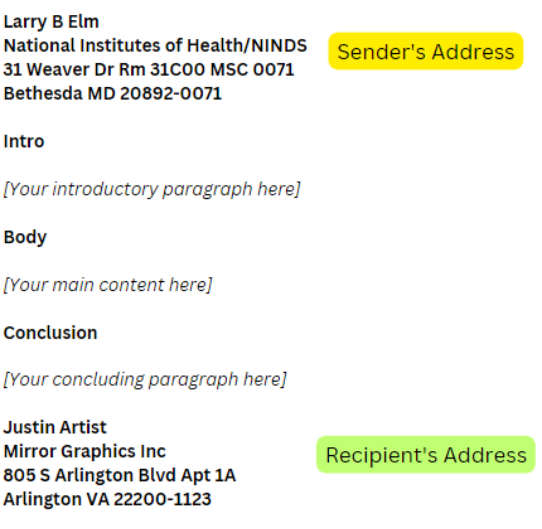
Informal letters:
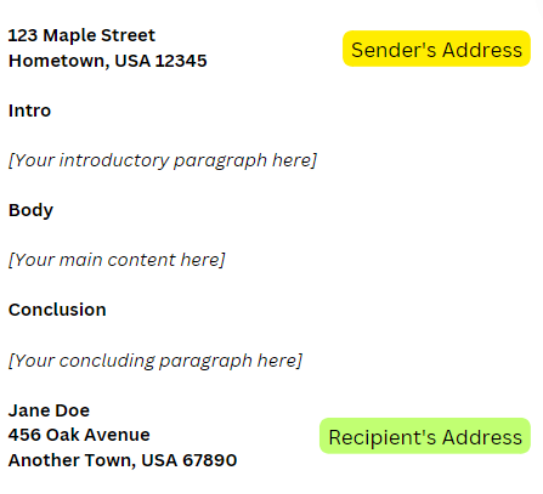
Business letters:
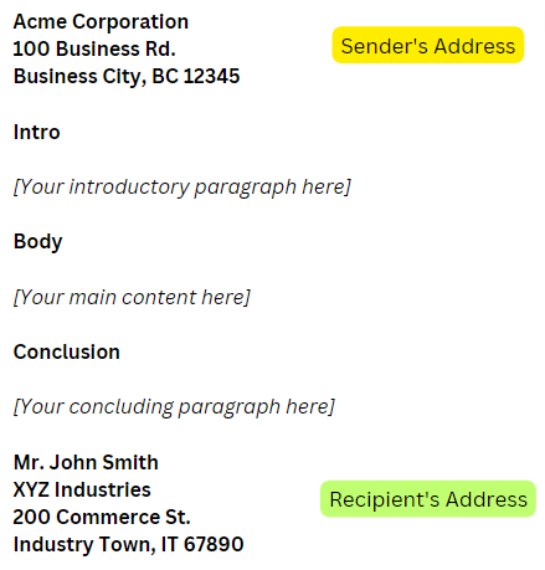
Official letters:
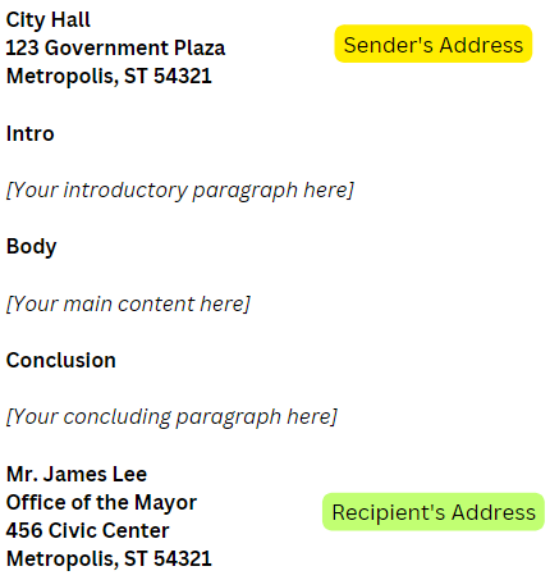
Letters to company representatives:
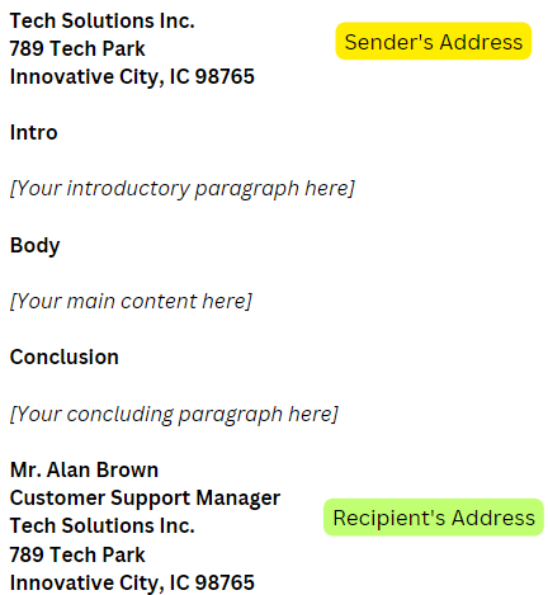
Letters to individuals:
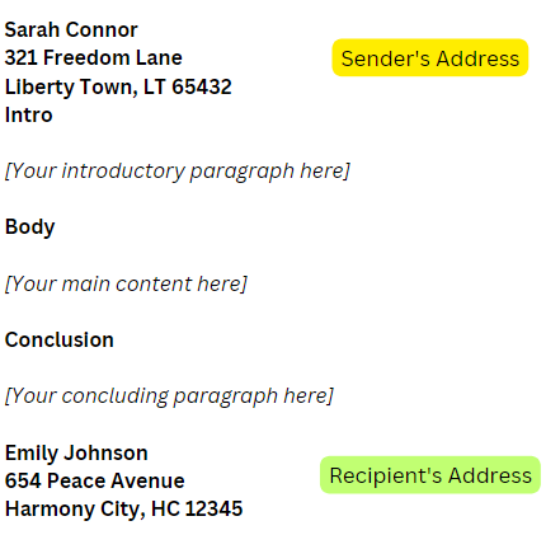
Letter Address Template
You can follow the template below to correctly format the address section of letters:
Sender information:
[Sender's full name]
[Sender's company or employer]
[Sender's city, province and postal code]
[Sender's phone number and email address]
Date:
[Date]
Recipient information:
[Recipient's full name]
[Recipient's title]
[Recipient's company name or employer]
[Recipient's city, province and postal code]
[Recipient's phone number and email address]
Greeting:
[Greeting] [Recipient's name]
Five-Step Letter Writing Method
When writing letters, you may feel at a loss where to start, especially when each type of letter has different formats. However, mastering this is important because in professional or academic environments, the way you write letters will directly affect the other party's impression of you and the effectiveness of communication. In this section, I will teach you to write letters using five simple steps. To make this process simpler, I will use XXAI to assist me.
A. Writing the Envelope Address
The first step in writing a letter is filling in the recipient's address. Ensure the letter can reach its destination. Here are the formatting methods:
1.Write the recipient's name. If you know their title (such as Mr., Ms., Dr., etc.), please include it. For example: "Mr. John Smith" or "Dr. Emily Johnson".
2.Fill in the recipient's job title or department (if any). For example: "Marketing Director" or "Human Resources Department".
3.Write the company or organization name (if applicable). For example: "Acme Corporation".
4.Next, write the street address using the "number + street name" format. For example: "123 Main Street" or "456 Oak Avenue, Suite 789".
5.Finally, write the city, state, and postal code. For domestic mail, please use the two-letter state abbreviation. For example: "San Francisco, CA 94122".
For international mail, add the country name on a new line. For example: "Canada" or "United Kingdom".
B. Salutation
After writing the address, the next step is the salutation. The salutation sets the tone of the letter and needs to be chosen based on your relationship with the recipient and the purpose of the letter. Here are some suggestions for common scenarios:
1.Known recipient: Use "Dear" followed by the title and surname. For example: "Dear Mr. Smith".
2.Unknown recipient: Use a general salutation. For example: "Dear Sir/Madam".
3.Sending to multiple people: If possible, list all names or use a group salutation. For example: "Dear Marketing Team".
4.Recommendation letters: Address specific individuals or committees. For example: "Dear Hiring Committee".
C. Letter Body
This is the core part of the letter, where you express your viewpoints, needs, or information in the letter body. A well-structured body ensures that information is clear and impactful.
1.Opening: Briefly state the purpose of writing. This helps readers immediately understand your intention. For example: "I am writing this letter to apply for the Marketing Manager position at your company".
2.Middle section: Elaborate on content in detail, provide supporting information, or expand on main points. Each paragraph should focus on one idea. For example: "Over the past seven years, I have continuously honed my marketing skills and currently serve as a Senior Marketing Specialist at XYZ Company…"
3.Conclusion: Clearly state what action you hope the other party will take next. This could be an interview request, further communication call, etc. For example: "I would be happy to discuss my experience and how I hope to contribute to your company. Feel free to contact me at: (555) 123-4567 or hi.xxai@email.com."
How to organize and write letter content is crucial. Imagine standing in front of them and talking to them. Your tone and content represent you, not your professional attire. Therefore, you need to ensure that letter content is not lengthy, appropriately expressed, and effectively conveys your message. To ensure this, I used XXAI.Here are some key features of XXAI that can help you handle letters more effectively:
Improve writing level: With XXAI's "improve writing level" function, I can ensure content effectiveness. XXAI can enhance information delivery, word choice, and overall professionalism, making it more effective.
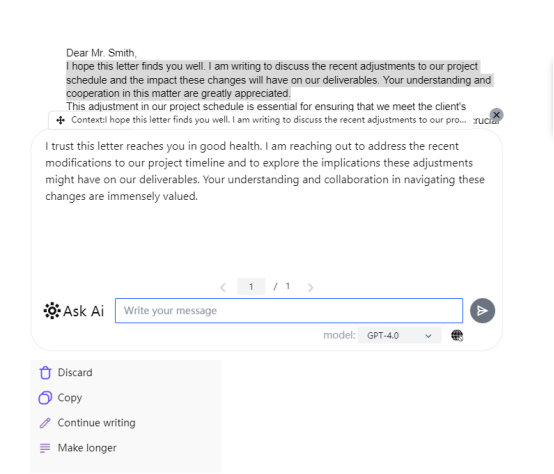
Shorten writing: With XXAI's "shorten" function, you can reduce paragraph length without losing the essence of information.
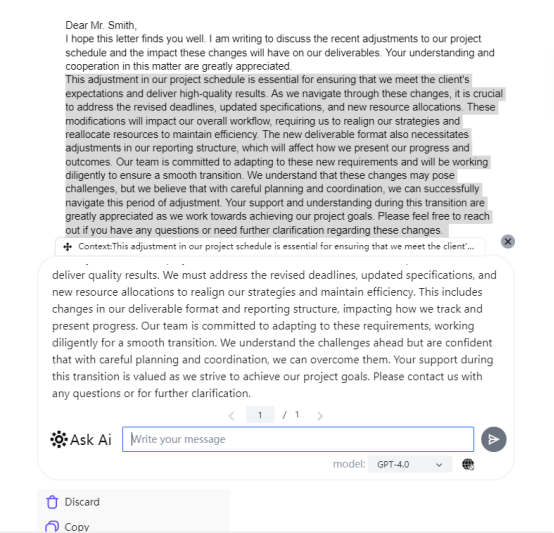
D. Closing
The end of the letter is where you leave the final impression. Choose a good closing phrase that is consistent with the overall tone of the letter. For formal business letters, use more conservative endings. For friendly or casual letters, you can use more enthusiastic endings.
E. Signature
Signatures make letters appear personalized and add authenticity. Here are methods for signing letters:
1.Write your full name at the end.
2.If you have a digital signature, you can insert it between your name and the closing.
3.Fill in contact information below your name (such as email, phone, etc.).
With the help of this guide, you will now have a better understanding of how to write letters, whether writing to companies, multiple people, recommendation letters, or any other situations.
Key Tips and Tools for Letter Writing
Correct letter addressing is crucial for ensuring your letters are received and handled appropriately. By following these guidelines, you can avoid common mistakes and improve the professionalism of your letters. Here are some important tips:
Check addresses: Ensure both your address and the recipient's address are correct and complete. This includes street names, apartment numbers, and postal codes.
Use appropriate titles: Use correct titles (Mr., Ms., Dr., etc.) to address recipients according to their preferences or professional titles, to show respect and professionalism.
Return address: Please place your address in the upper left corner of the envelope to ensure letters can be returned to you if delivery fails.
Clear and readable: Write or type addresses clearly and readably to avoid confusion and ensure correct delivery.
Add postage: Ensure correct postage is affixed to avoid delays or non-delivery.
Professional format: For formal letters, use consistent and professional formatting, including names, addresses, and dates at the top of letters.
Review and proofread: Before sending, be sure to review and proofread your letter and address details to discover any errors.Using XXAI's spell check function is particularly useful in this process because it can identify and correct spelling and grammar errors to ensure your letters are perfect and professional.
Using XXAI: To perfect your formal letters, consider using XXAI. Its advanced features can help you refine formatting, suggest improvements, and ensure your letters meet professional standards.
Common Questions About Letter Writing
1. What to do when you don't know the recipient's name?
If you don't know the recipient's name, use general greetings such as "Dear Sir/Madam" or "To Whom It May Concern". But try to identify specific contacts, as personalized salutations can greatly enhance your communication impact and professionalism.
2. How to address married couples when writing letters?
To write envelopes to married couples, use the following formats:
- Traditional format:
Mr. and Mrs. [Husband's full name]
[Street address]
[City, State ZIP code]
- Individual names:
Mr. [Husband's full name]
Mrs. [Wife's full name]
[Street address]
[City, State ZIP code]
The "Mr. and Mrs." form of address is still the most traditional and commonly used way to address married couples. Alternatively, listing each spouse's name separately with the husband's name first is also appropriate, especially in formal occasions. It's important to include both parties' full names to maintain clarity and show respect.
3. How to write to judges?
When writing to judges, use the following format:
Begin with "Honorable" followed by the judge's full name.
Include their official title (for example, "Chief Justice" or "Justice" for Supreme Court justices).
Specify the name of the court they preside over.
Provide the court's mailing address.
Conclusion
Correct letter addressing is very crucial for effective communication. I hope this guide above can help you write letters with more confidence, whether for formal occasions or various communication needs. Keeping correct methods in mind helps ensure letters are professional and polite.Consider using tools like XXAI to easily write clear and effective letters.
Experience writing a perfect letter with XXAI right now!